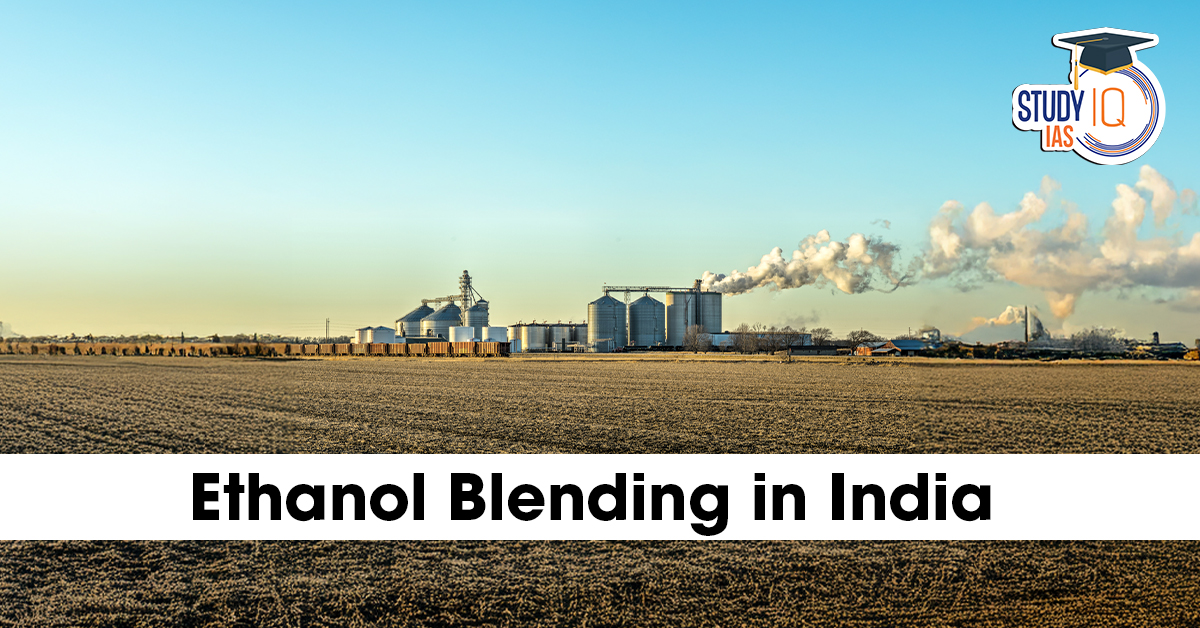Table of Contents
Context: India pushes ethanol blending for fuel import savings and lower emissions, but faces challenges.
What is Ethanol and Why is it Used
- Definition: Ethanol (C₂H₅OH) is a renewable biofuel made by fermenting sugars from biomass (e.g., sugarcane, maize, broken rice, molasses).
- Nature: Colourless, volatile liquid; oxygenated fuel.
- Use in fuel: Mixed with petrol to form blends like E5, E10, E20 (E = ethanol, number = % ethanol in blend).
- Origin of blending:
- Initiated in the early 2000s, scaled up under the Ethanol Blended Petrol (EBP) Programme.
Benefits claimed
- Carbon neutrality (though debatable in practice).
- Import substitution: For India, 20% blending could save ~$10 billion annually.
- Lower prices (though not always reflected at fuel pumps).
Current Status
- 2014: The Blending level was just 53% under the Ethanol Blended Petrol (EBP) Programme.
- 2022: Achieved 10% blending five months ahead of target.
- Original Goal: 20% blending (E20) set for 2030.
Revised Goal: Advanced to 2025 due to faster progress. - Current Status (Current ESY): E20 blending achieved ahead of the 2025 target.
| ESY |
| The ethanol supply year runs from October to November. |
Feedstock in India
- C-heavy molasses (by-product of the sugar industry).
- Damaged/broken rice.
- Maize and other starch-based crops.
Ethanol Blending In India: Downsides and Concerns
Agricultural & Food Security Risks
- Diverts crops like rice and maize from food to fuel, especially during years of shortage.
- Once the ethanol economy matures, political and economic pressure may prioritise industry over food needs.
Economic Limitations
- Import substitution benefits are reduced if farm inputs (e.g., fertilisers) are imported (fertiliser imports cost ~$10B annually).
- Retail fuel price reductions are not visible despite cheaper ethanol.
Technical / Engineering Issues
- Efficiency penalty: Lower energy density compared to petrol.
- Material durability & corrosion: Can damage fuel handling systems over time.
- Vehicle compatibility: BS 2 norms (India, since 2001) can handle up to E15 safely.
- Vehicles since 2023 have been designed for E20.
- Older vehicles may not be compatible beyond E5.
Policy & Market Concerns
- No consumer choice: Blended petrol is the default, even for older vehicles not designed for higher ethanol content.
- Price claims not visible: Lower cost of ethanol blending not reflected in retail prices.
- Transparency gap: Automakers not disclosing ethanol tolerance of older models.
- Lack of clear mitigation measures for older vehicles.
- Insurance & liability: The Government should back claims if ethanol damage occurs.
Major Takeaways / Policy Needs for India
- Clear vehicle compatibility disclosures: Automakers should publish ethanol tolerance for all past models.
- Mitigation plans: For older vehicles (e.g., fuel system upgrades, material replacements).
- Insurance safeguards: Ensure ethanol-related damages are covered.
- Food security balance: Avoid displacing food crops or risking shortages.
- Transparent pricing: Pass ethanol blending savings to consumers.
- Gradual rollout with norms: India is adopting E27 norms (following Brazil), but must ensure readiness before scaling.


 Bonnet Macaques: Habitat, Features, Beha...
Bonnet Macaques: Habitat, Features, Beha...
 Periyar Tiger Reserve, Map, Flora, Fauna...
Periyar Tiger Reserve, Map, Flora, Fauna...
 Project Cheetah in India, Objectives, Ch...
Project Cheetah in India, Objectives, Ch...

























